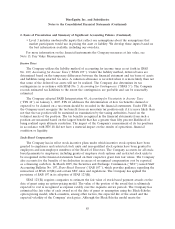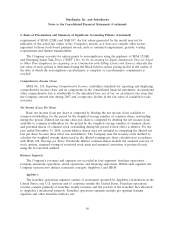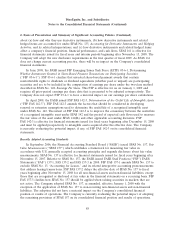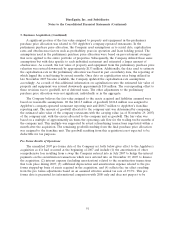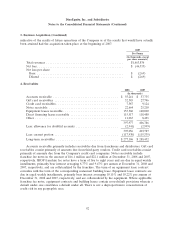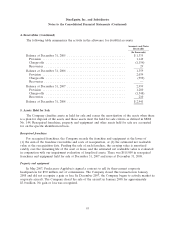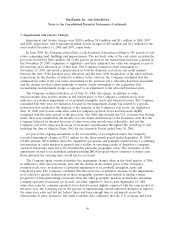IHOP 2008 Annual Report Download - page 100
Download and view the complete annual report
Please find page 100 of the 2008 IHOP annual report below. You can navigate through the pages in the report by either clicking on the pages listed below, or by using the keyword search tool below to find specific information within the annual report.DineEquity, Inc. and Subsidiaries
Notes to the Consolidated Financial Statements (Continued)
2. Basis of Presentation and Summary of Significant Accounting Policies (Continued)
requirement of SFAS 123(R) and SAB 107, the fair values generated by the model may not be
indicative of the actual fair values of the Company’s awards, as it does not consider other factors
important to those stock-based payment awards, such as continued employment, periodic vesting
requirements and limited transferability.
The Company accounts for option grants to non-employees using the guidance of SFAS 123(R)
and Emerging Issues Task Force (‘‘EITF’’) No. 96-18, Accounting for Equity Instruments That are Issued
to Other Than Employees for Acquiring, or in Conjunction with Selling, Goods and Services, whereby the
fair value of such options is determined using the Black-Scholes option pricing model at the earlier of
the date at which the non-employee’s performance is complete or a performance commitment is
reached.
Comprehensive Income (Loss)
SFAS No. 130, Reporting Comprehensive Income, establishes standards for reporting and displaying
comprehensive income (loss) and its components in the consolidated financial statements. Accumulated
other comprehensive loss is attributable to the unrealized loss, net of tax, on an interest rate swap that
the Company entered into during 2007 and a temporary decline in the fair value of available-for-sale
securities.
Net Income (Loss) Per Share
Basic net income (loss) per share is computed by dividing the net income (loss) available to
common stockholders for the period by the weighted average number of common shares outstanding
during the period. Diluted net income (loss) per share is computed by dividing the net income (loss)
available to common stockholders for the period by the weighted average number of common shares
and potential shares of common stock outstanding during the period if their effect is dilutive. For the
year ended December 31, 2008, certain dilutive shares were not included in computing the diluted net
loss per share because their effect was anti-dilutive. The Company uses the treasury stock method to
calculate the weighted average shares used in the diluted earnings per share calculation in accordance
with SFAS 128, Earnings per Share. Potentially dilutive common shares include the assumed exercise of
stock options, assumed vesting of restricted stock units and assumed conversion of preferred stock
using the if-converted method.
Business Segments
The Company’s revenues and expenses are recorded in four segments: franchise operations,
company restaurant operations, rental operations, and financing operations. Within each segment, the
Company operates two distinct restaurant concepts: Applebee’s and IHOP.
Applebee’s
The franchise operations segment consists of restaurants operated by Applebee’s franchisees in the
United States, one U.S. territory and 15 countries outside the United States. Franchise operations
revenue consists primarily of franchise royalty revenues and the portion of the franchise fees allocated
to Applebee’s intellectual property. Franchise operations expenses include pre-opening training
expenses and other franchise-related costs.
86











